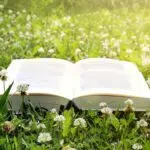Gardening, Nature and Ecology Books Month is held in March every year. It’s a day to celebrate all green thumbs, plant enthusiasts, nature lovers, and plantsmen and their favorite nature books. This month-long celebration is a great opportunity to learn more about mother nature and the simple, domestic ways to combat climate change. But don’t get intimidated; today’s not just for prolific environmentalists, as every plant owner and nature bookworm are invited to the party! Learn more about the ways in which you can celebrate this green revolution holiday.
History of Gardening, Nature and Ecology Books Month
Gardening played a vital role in ending our ancestors’ nomadic lifestyle and beginning a settled community. Before modern civilization developed an eye for gardening aesthetics and design, planting was done as a necessity rather than as a leisure activity. More than 23,000 years ago, humans started planting seeds and growing their food in their backyards. This signified the start of communities staying in the same area, marking their territories, and harvesting their crop.
In ancient times, kingdoms in Babylon, Egypt, and Persia spent a huge amount of their cities’ wealth on constructing elaborate gardens. What’s more, they pioneered the technology of irrigation systems, which became a vital part of modern-day gardening. This was due to their geographic locations, as these kingdoms were situated in the middle of the desert, where water was scarce. They had to develop a water system that would grow and sustain the seeds they planted. And out of all the ancient gardens, the Hanging Gardens of Babylon were the most popular; in fact, they were considered one of the Seven Wonders of the Ancient World.
Gardening’s popularity decreased when the Roman Empire fell. However, it quickly picked up its pace during the Middle Age, when monks started planting flowers and herbs in their monasteries. By the 17th century, the art of garden design reached immense popularity in Europe, where people would construct luxurious gardens in their homes.
Modern gardening didn’t reach the U.S. until the mid-20th century, after World War II. The rise of suburban development encouraged homeowners to develop flower bed designs and practice home gardening. By the 1990s, container gardening became fashionable with plants that thrive in tight, indoor settings.
Gardening, Nature and Ecology Books Month timeline
Nomads settle down to plant seeds and harvest their food.
The kingdoms of Egypt, Persia, and Babylon develop irrigation systems to sustain their elaborate gardens.
Monks begin planting herbs and flowers in monasteries.
Garden design’s popularity reaches Europe.
Gardening becomes popular in the U.S., following World War II’s suburban development.
Container gardening becomes a trend.
Gardening, Nature and Ecology Books Month FAQs
What is a horticulturist?
A horticulturist is an expert in all things gardening, including management and cultivation.
What is the greenhouse effect?
The greenhouse effect is the warming of the Earth’s surface caused by the presence of carbon dioxide and other greenhouse elements.
What flower is the easiest to grow?
Sunflowers and zinnias are the easiest flowers to plant, manage, and grow. They require little care and attention, and they grow back year after year.
Gardening, Nature and Ecology Books Month Activities
Plant a seed
The best way to celebrate Gardening, Nature and Ecology Books Month is to plant a seed in your backyard. There’s nothing better than witnessing a flower grow after weeks of watering and nourishing. Make gardening a hobby!
Read a nature book
There’s so much to learn about ecology, gardening, and the environment. This month is the perfect time to read a nature book and learn more about the importance of gardening in today’s climate crisis. Once you’re done reading, post a photo of your book on social media using the hashtag #GardeningNatureAndEcologyBooksMonth.
Be creative with your gardening design
Looking for an opportunity to explore your creative juices? Try garden design! It’s a fun way to experiment with aesthetics and flower arrangements. You can also research on YouTube and Pinterest for inspiration on decorating your garden space.
5 Facts About Plants And Gardening
A sunflower has thousands of flowers in it
One sunflower is composed of 2,000 individual flowers on one stalk.
Baking soda sweetens your crops
Regularly sprinkle a dash of baking soda on your plant’s soil to sweeten your tomatoes.
Some fruits are roses
Fruits such as apples, cherries, peaches, and pears come from the rose family.
Plants react to sound
The myth is true: music can improve a plant’s growth.
Home gardeners can combat climate change
Home gardening reduces carbon emissions and increases the soil’s carbon storage — a vital process in fighting climate change.
Why We Love Gardening, Nature and Ecology Books Month
It’s a fun hobby
If you’re an introvert looking for an activity you can do at home, gardening is for you. It’s a fun hobby where you can get creative while learning about nature and ecology.
It fights global warming
Gardening, Nature and Ecology Books Month is an opportunity for everyone to practice the simplest ways to combat climate change. It’s a crucial time for our planet, and month-long holidays like this allow us to be proactive in nurturing our environment.
It’s educational
Few reads are as rewarding as reads about nature and ecology. By reading nature books, we develop a sense of awareness about how we can make our planet a better place.
Gardening, Nature and Ecology Books Month dates
| Year | Date | Day |
|---|---|---|
| 2026 | March 1 | Sunday |
| 2027 | March 1 | Monday |
| 2028 | March 1 | Wednesday |
| 2029 | March 1 | Thursday |
| 2030 | March 1 | Friday |














































































































































